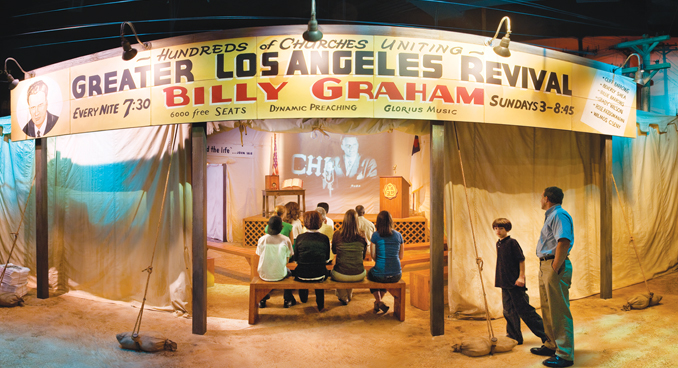
Courtesy Billy Graham Evangelistic Association
One of the joys of traveling is finding the small differences between places, the cultural, historical or geographical attributes that make every city, town and village stand apart from the next. In the Carolinas, discovering these unique characteristics will take you on a journey from the mountains to the sea, from the highlands to the Lowcountry and from the distant past to the present day.
History in North Carolina and South Carolina is wide-ranging and diverse. From native populations who lived in the area before the arrival of Europeans to the Gullah culture of the coastal South, visitors will find plenty of stories to explore, each with its own personalities and distinct characteristics.
There are dozens of interesting sites around both states that provide a glimpse of distinct local history and tradition. Here are three to consider visiting on your next tour.
Roanoke Canal Museum and Trail
Roanoke Rapids, N.C.
In the mid-1800s, engineers created the Roanoke Canal in northeastern North Carolina to help boats navigate around the Roanoke Rapids and other treacherous areas. The canal soon became an important component of shipping and energy. Today, the Roanoke Canal Museum and Trail tells the story of the area.
“Our museum outlines how the canal was used for trade and navigation in the early 19th century,” said museum manager Lance Jenkins. “Because of the canals, we became a major port. The biggest thing we were known for was the ability to go into the West.”
Although the canal no longer exists, the museum has exhibits that describe the important role it played in transportation and shipping in its prerailroad heyday. Prized artifacts include a bateau, which was the primary vessel used to transport goods down the canal, and a 19th-century wood turbine, which was used at a nearby grain mill.
The museum displays also cover the town of Roanoke Rapids and the use of the canal to generate electricity in the 20th century.
“You can walk through some authentic history,” Jenkins said. “This building was built as part of the canal system. It’s been remodeled as a museum, but when they were generating electricity, it was a powerhouse. It’s one of two buildings like this on the canal.”
Groups can also walk portions of a trail that was created along the former canal, where they might see some of the 168 species of birds that live in the area.
www.roanokecanal.com
Billy Graham Library
Charlotte, N.C.
The modern city of Charlotte is one of the business and cultural capitals of the South, but students of 20th-century history will also recognize it as the home of Billy Graham, one of America’s most influential religious leaders.
Today, the Billy Graham Library tells visitors about the evangelist’s early life in Charlotte and his outreach work that spanned more than five decades.
“Billy Graham was born here in Charlotte in 1918, and his first home was about three miles from where the library is now,” said Diane Wise, promotions manager at the library. “He’s one of Charlotte’s native sons, so they decided they wanted to have a place here where his crusade message could continue on into history.”
The barn-shaped museum building symbolizes Graham’s early life on a family dairy farm. Exhibits in the museum go from there to deal with his early crusades, his pioneering use of radio and television and his relationships with U.S. presidents and other world leaders.
Although the museum puts a strong emphasis on the message Graham preached, some sections have a more personal touch.
“You see artifacts from throughout his life and his marriage to Ruth Bell Graham,” Wise said. “There’s a room that tells about Ruth’s background growing up as a missionary in China and about their married life together. Her wedding dress that she made is on display there. It’s a very personal room.”
Groups can have lunch at the library’s Graham Brothers Dairy Bar or visit the family’s original farmhouse, which has been moved onto the museum campus.
Upcountry History Museum
Greenville, S.C.
Many visitors to South Carolina are familiar with the term Lowcountry, which describes the coastal areas around Charleston and the southern part of the state. But the lesser-known Upcountry, in the northwestern corner, has a distinct geography and history of its own. Visiting groups can learn about both at the Upcountry History Museum in Greenville.
“We have permanent exhibits that span the time of human habitation in the Upcountry,” said Dawn Hammat, managing director at the museum. “We start with the Native American populations that were here and then move on to the early Colonial time. We tend to spend a lot of time on more modern issues, too.”
The museum uses historic artifacts and audiovisual presentations to educate guests on the Upcountry’s history. One section deals with two different Native American groups in the area, describing how they interacted with each other and with the first European colonists. Another exhibit features a video presentation of one local family’s experience during the Revolutionary War.
During the 1920s, textile mills became a dominant industry in the area, and a large portion of the museum is dedicated to describing its impact on local life.
“In our Mill Village, we talk about how textiles became a major part of this area,” Hammat said. “We talk about how the citizens moved from the farms to the mill villages. We have a replica of a mill and three people inside that tell you their stories.”
For more on the Carolinas:
Gardens get blooming recognition
Artful insights
Historic flavor
WEB EXCLUSIVE! 10 plantation homes in the Carolinas












